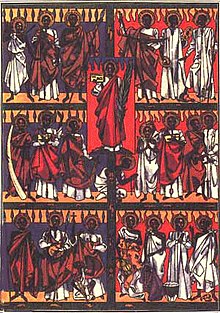Ugandan Martyrs
| Charles Lwanga and Companions |
|
|---|---|
 |
|
| Died | 1885–1887, Uganda |
| Martyred by | Mwanga II |
| Venerated in |
Roman Catholic Church Anglican Communion Lutheranism |
| Beatified | 1920, by Pope Benedict XV |
| Canonized | 18 October 1964, by Pope Paul VI |
| Major shrine | Basilica Church of the Uganda Martyrs, Namugongo Munyonyo Martyrs Shrine |
| Feast | 3 June |
| Notable martyrs |
Charles Lwanga Kizito Andrew Kaggwa |
| Daudi Okelo and Jildo Irwa | |
|---|---|
| Born | c.1900 (Daudi); 1906 (Jildo) |
| Died | 18 October 1918, Paimol, Uganda |
| Means of martyrdom | pierced with spears |
| Venerated in | Roman Catholic Church |
| Beatified | 20 October 2002, by Pope John Paul II |
| Feast | October 18 |
The Uganda Martyrs are a group of 23 Anglican and 22 Catholic converts to Christianity in the historical kingdom of Buganda, now part of Uganda, who were executed between 31 January 1885 and 27 January 1887.
They were killed on orders of Mwanga II, the Kabaka (King) of Buganda. The deaths took place at a time when there was a three-way religious struggle for political influence at the Buganda royal court. The episode also occurred against the backdrop of the "Scramble for Africa" – the invasion, occupation, division, colonization and annexation of African territory by European powers. A few years after, the English Church Missionary Society used the deaths to enlist wider public support for the British acquisition of Uganda for the Empire. The Catholic Church beatified the martyrs of its faith in 1920 and canonized them in 1964.
Publication in Britain of an 1875 letter purporting to be an invitation from the king of Buganda, Muteesa I, to send missionaries, resulted in the arrival of missionaries of the Anglican Church Missionary Society to Buganda in 1877. A group of French Catholic White Fathers appeared two years later. This was followed by a Zanzibar-based Arab attempt to introduce Islam. This effectively led to a three-way religious struggle for political influence at the Buganda royal court. By the mid-1880s, many had been converted by each of the three groups, and some of the converts held important posts at the king's court. Muteesa himself sympathized with Islam, but many prominent chiefs had become Christians.
Kabaka Mwanga II succeeded to the throne in 1884. He was concerned at the growing influence of Christianity and the rise of a new class of officials, distinct from the traditional territorial chiefs, who were educated, had a religious orientation, and wished to reform Ganda society. The German annexation of what is now Tanzania sparked further alarm. A year after becoming king he ordered the execution of Yusufu Rugarama, Makko Kakumba, and Nuwa/Noah Serwanga, who had converted to Christianity. Encouraged by his prime minister, on 29 October 1885 he had the incoming Anglican bishop James Hannington assassinated on the eastern border of his kingdom. This is often taken to be the thoughtless action of a 19-year-old king, but, according to Ward, can also be interpreted as justifiable action intended to ward off any invasion. Nevertheless, Mwanga did go on to appoint several Christians to important military positions.
...
Wikipedia
